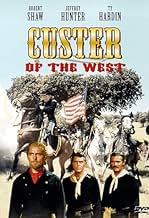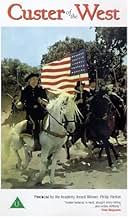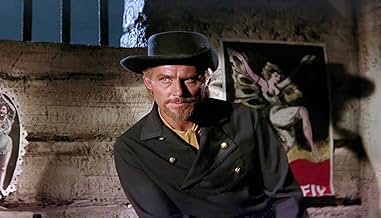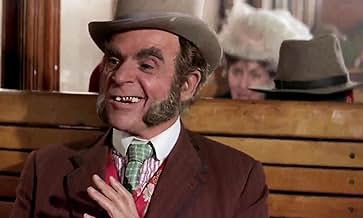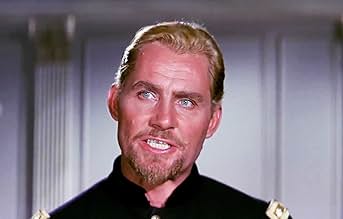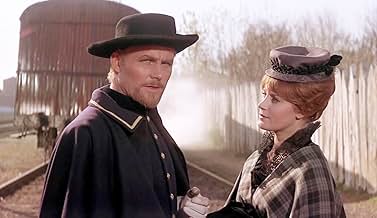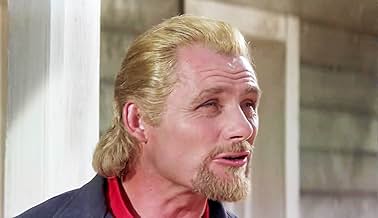Der extravagante Bürgerkriegsheld Custer übernimmt das Kommando über die 7. Kavallerie und will die Reservationspläne der vertragsbrüchigen US-Regierung gegen die aufsässigen Indianer mit Ge... Alles lesenDer extravagante Bürgerkriegsheld Custer übernimmt das Kommando über die 7. Kavallerie und will die Reservationspläne der vertragsbrüchigen US-Regierung gegen die aufsässigen Indianer mit Gewalt durchsetzen. Doch die wehren hartnäckig.Der extravagante Bürgerkriegsheld Custer übernimmt das Kommando über die 7. Kavallerie und will die Reservationspläne der vertragsbrüchigen US-Regierung gegen die aufsässigen Indianer mit Gewalt durchsetzen. Doch die wehren hartnäckig.
Empfohlene Bewertungen
I think your enjoyment of "Custer of the West" depends a lot on what your opinions are of the man, if any. As a former US History teacher, I look on the man as a very failed (if not a bit stupid) leader...so since I am not a fan, it made enjoying the film more difficult. More difficult still is that the movie didn't do a lot to humanize the man or tell you who he was apart from some general/lieutenant colonel.
Overall, reasonably good but not exactly a crowd-pleaser.
Though I live overseas now I grew up in the United States in the 1960s (in fact, I still retain my U.S. citizenship). Some of the lines in this 1967 movie are, in fact, anachronisms (they were not in the language in the 1860s or 1870s when this movie was set). The phrase that one U.S. soldier was worth (in combat) 10 Indians was a takeoff on the phrase used at that time in the Vietnam War concerning the kill ratio. Also, the term that General Sheridan used, "Bleeding hearts" comes from the 1960s; not the 1860s. The director of this movie was obviously comparing the moral problems we felt with Vietnam with the same problems the U.S. felt during the Indian Wars a century before. I did not know, of course, any Indian War veterans, but I did know two good men who went to Vietnam and did not come back alive.
Also tearful is the real life love you detect between George and Libby Custer that is portrayed by the real life married couple of Robert Shaw and Mary Ure. Six children between them. She died about ten years later from an accidental overdose of alcohol mixed with sleeping pills. He was so heartbroken that he died a few years later literally of a broken heart.
It is still a magnificent film. The western scenes are indigenous to that part of the United States that it is actually a shock to find out they were filmed not in South Dakota, California, Nevada, Kansas,etc. but rather in Spain!!
This movie well produced by Philip Jordan blends good action scenes, shootouts , adventures and being quite entertaining , because happen many deeds and fast-moving and that's why it is neither boring , nor dreary, but entertaining . George Armstrong Custer's complex characterization with an unusual point of view is well performed by Robert Shaw who gives a nice embodiment of this Western hero. Robert Shaw's interpretation as a hippie-type, long-haired general , is top-notch , unfortunately he early died , in fact , this is his last film . His wife in the real life, Mary Ure being early dead , as well. The thrilling final confrontation between Custer army and Indians is spellbound and breathtaking similar to ¨ They died with the boots on (1941)¨ with Errol Flynn and directed by Raoul Walsh . The film obtained a limited success in spite of the lavish budget and spectacular sets . Direction by Robert Siodmak is average , in spite of a long career with many cinema classics (Criss Cross , The killers , The spiral staircase , The suspect) and the film is mediocre and overlong , too. The great director Fred Zinnemann even directed some scenes and originally to be directed by Akira Kurosawa, but he ruled out . Cecilio Paniagua's cinematography is glimmering and fascinating and photographed in Super Technirama 70 , the outdoor scenarios are overwhelming , this is the best of the film . Bernardo Segall musical's score is sensitive and moving and performed by Royal Philarmonic orchestra. Splendidly staged battles with obligatory cast of hundreds is well made by the art directors Eugene Lourie and Julio Molina . The motion picture will appeal to biopic enthusiasts and Indians western buffs.
Other adaptations about this historic character culminating in thrilling battle of Little Big Horn are the following ones : ¨Santa Fe trail¨ by Michael Curtiz with Ronald Regan as Custer ; ¨Great massacre Sioux¨ by Sidney Salkow with Philip Carey as Custer and Iron Eyes Cody as Crazy Horse ; ¨Little Big Man¨ by Arthur Penn with Richard Mulligan as Custer ; ¨Son of the morning star¨ TV miniseries by Mike Robe with Gary Cole , among others.
"Custer of the West" both stresses the mistreatment of the plain's Indians by the U.S. and portrays Custer as a tragic American hero who was a puppet of government policy. The film is usually lambasted for its inaccuracies, particularly its depiction of the closing battle. For instance, in real-life Custer's soldiers surprised the Native encampment, they didn't ride up and dialogue with the waiting Indians; moreover, the battle was a chaotic one, moving toward Last Stand Hill. Yet it's not like previous films were any more accurate, e.g. "They Died with Their Boots On" (1941), but audiences apparently demanded more accuracy by the late 60s.
Regardless, the gist of events is true: Reno and Benteen were real-life subordinate officers at odds with Custer and reportedly failed him on the day of battle, although they supposedly had justified cause. If I were Benteen, I would've probably done what he did in the face of Custer's glory-hound rashness and a formidable foe: Dig in, face the enemy, and survive to fight another day. In any case, if you want historical accuracy (to a point) see "Son of the Morning Star" (1991).
The main problem I have with this movie are the Spanish locations substituting for Virginia, the Dakotas and Montana. Fortunately, the creators at least tried to find a setting with trees for Virginia and some of the locations they used for Dakota/Montana occasionally work (just occasionally). But there's a long desert sequence when nothing of the sort exists in the region. You'd have to go far south to New Mexico/Arizona or way further west to eastern Washington to find such deserts. Yet it could be argued that the desert sequence is substituting for the Badlands of the Western Dakotas, which is certainly desert-like.
If you can ignore the disingenuous topographies, there's a lot to appreciate in "Custer of the West." But the film's overlong and bogged down by tedious or useless sequences, like the capture/imprisonment of Sgt. Mulligan (Robert Ryan). But there are some gems, like when Dull Knife (Kieron Moore) pays Custer a visit at the fort (which in real life didn't have a timber stockade). Custer bluntly conveys to the Chief the simple (awful) truth about conquerors and those they conquer: "The problem is precisely the same as when you Cheyenne decided to take another tribe's hunting ground. You didn't ask them about their rights. You didn't care if they had been there a thousand years. You just had more men and more horses. You destroyed them in battle. You took what you wanted and, right or wrong, for better or worse, that is the way things seem to get done. That's history."
FYI: Deviating from the original script, Robert Shaw made the character of Custer over to suit himself, turning him into a "sadist of Shakespearean depth." He also directed the battle scenes with Siodmak staging everything else.
THE MOVIE RUNS 2 hours 21 minutes and was mostly shot 30 miles from Madrid, Spain, except for the Battle of Little Bighorn which was filmed in Costa del Sol near Almira. WRITERS: Bernard Gordon and Julian Zimet with additional work by Shaw.
GRADE: C
MARY URE as his wife, Libby, has little to do but register impatience with being kept in the background between battles with long waits before she shares the screen with real-life hubby, ROBERT SHAW. A more mature looking JEFFREY HUNTER (sporting gray hairs) is Will Benteen, one of Custer's more loyal officers.
The mountainous plains in Spain are no substitute for our standard glimpses of John Ford territory with not a single shot looking as though photographed in the American West. But it's the dull storyline that defeats the movie from ever becoming anything more than a series of handsomely photographed outdoor sequences. A surprise Indian attack by the Cheyennes on an Indepdence Day Celebration is one of the more colorful moments and triggers Custer's determination to fight the redskins, no matter that they greatly outnumber his men.
Nothing in Shaw's performance suggests the color and vigor of Custer's bigger than life personality nor does the screenplay do any real justice to the man or the myth. As storytelling goes, the first half of the film manages to be just plain dull and the film only picks up speed as it nears the climactic fight at Little Big Horn.
Battle skirmishes with Indians are, on the whole, well staged and full of furious gunsmoke and flying arrows--but the big set piece is saved, of course, for the finale which comes too late to save the first half of the film from the doldrums. One is left with the impression that some inventive fictionalizing would have helped (as it did with THEY DIED WITH THEIR BOOTS ON).
Summing up: A very miscast Shaw plays Custer as a snarling villain who barks orders and the story has a plodding script. Could have been much more impressive if filmed in the U.S. on more realistic locales with more accurate casting. A cameo by ROBERT RYAN is no help at all.
Wusstest du schon
- WissenswertesSome sources have suggested that this was originally to be directed by Akira Kurosawa, but he pulled out. However, this is massively unlikely, given the production history of the film. The more likely explanation is that Kurosawa was approached about directing a different film project on the same subject, "The Day Custer Fell", which was in the works at 20th Century Fox for several years, and for which several Japanese actors famous for working with Kurosawa were approached to play the leading Native American roles. Fred Zinnemann was eventually attached to this project, but it was canceled by Fox because of its ever-escalating budget. "Custer Of The West" was put together very quickly (and made rather cheaply) once this occurred.
- PatzerThe troops of the 7th Cavalry are shown with 1873 Winchester rifles, which were in wide use by 1876, but not by the US Army. Custer's men were armed, as all troopers who did not purchase their own rifles were, with the 1873 Springfield Trapdoor carbine, a single-shot weapon. Had Custer's men been armed with the Winchester, it is possible, though unlikely, that they could have held out until relieved.
- Zitate
Gen. Philip Sheridan: You know, you could become a living legend... or get yourself killed. Dead men make better legends.
- Alternative Versionen35mm prints released in both complete and shortened versions. Some shortened versions were titled "A Good Day for Fighting".
- VerbindungenFeatured in I Am Not Your Negro (2016)
Top-Auswahl
- How long is Custer of the West?Powered by Alexa
Details
- Erscheinungsdatum
- Herkunftsländer
- Sprache
- Auch bekannt als
- Last Post - US Kavallerie Western-Klassiker Box
- Drehorte
- Produktionsfirmen
- Weitere beteiligte Unternehmen bei IMDbPro anzeigen
Box Office
- Budget
- 4.000.000 $ (geschätzt)
- Laufzeit
- 2 Std. 20 Min.(140 min)

